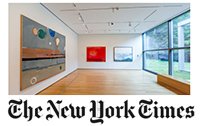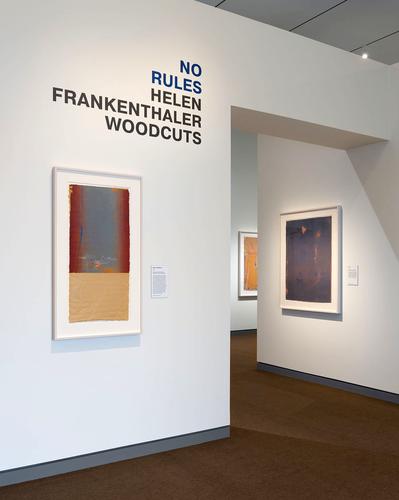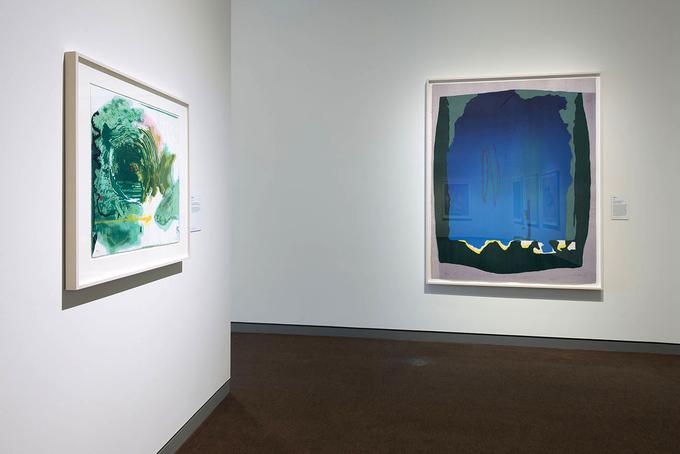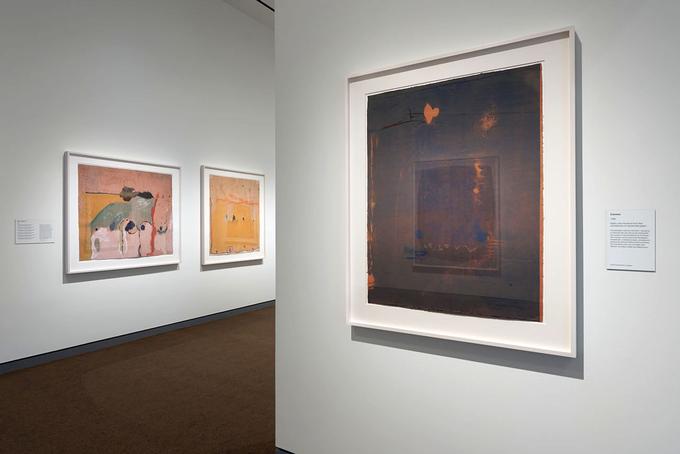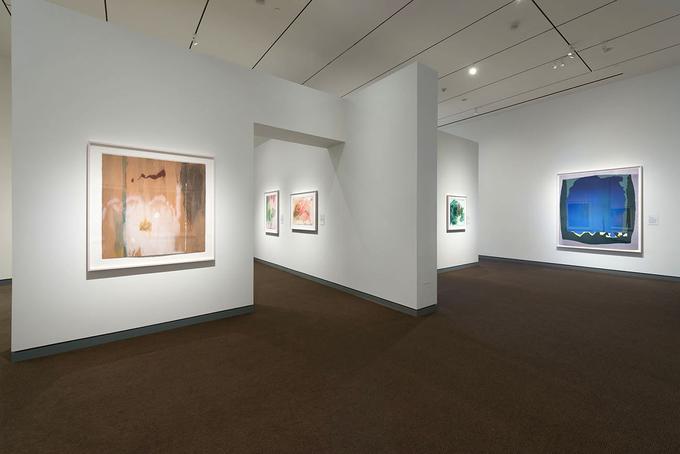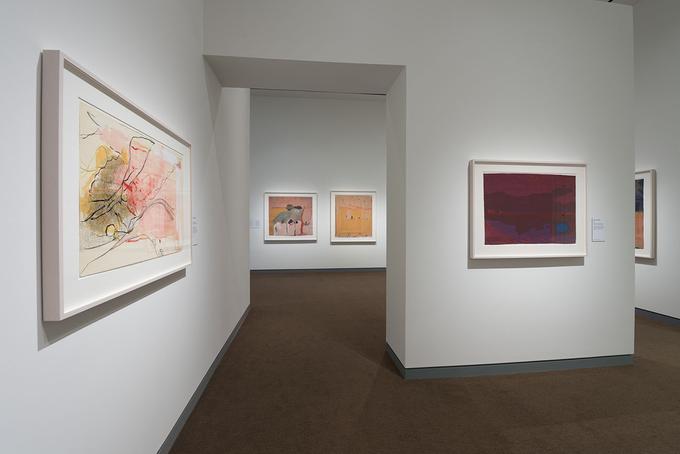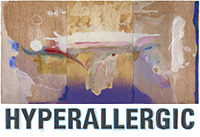
No Rules: Helen Frankenthaler Woodcuts
The Clark Art Institute
Williamstown, MA
July 1 — September 24, 2017
Press Release / Info
Exhibition explores abstract artist’s groundbreaking approach to the medium
Williamstown, Massachusetts—No Rules: Helen Frankenthaler Woodcuts, on view
exclusively at the Clark Art Institute July 1–September 24, explores Helen
Frankenthaler’s (American, 1928–2011) inventive and groundbreaking approach to the
woodcut. Seventeen large-scale prints, on loan primarily from the Helen Frankenthaler
Foundation and the Williams College Museum of Art, present the full range of
Frankenthaler’s experimentation with the medium from the 1970s through 2000s. The
exhibition explores the artist’s collaborations with printers, publishers, woodcarvers, and
papermakers that pushed the medium in new directions. In 1994, during an interview with
printer/publisher Ken Tyler, Frankenthaler stated, “There are no rules, that is one thing I
say about every medium, every picture . . . that is how art is born, that is how
breakthroughs happen. Go against the rules or ignore the rules, that is what invention is
about.” No Rules celebrates the pioneering spirit that expanded the possibilities of the
woodcut and established Frankenthaler as one of the medium’s great innovators.
No Rules is one of two Frankenthaler exhibitions on view at the Clark this summer. In
addition to the exhibition of her woodblock prints, the Clark presents As in Nature: Helen
Frankenthaler Paintings, which focuses on nature as a long-standing inspiration for the
artist. As in Nature is presented in the Lunder Center at Stone Hill and is on view July 1–
October 9.
The Clark renews its association with the artist this summer through these exhibitions.
Helen Frankenthaler maintained a lifelong connection to Bennington College, located less
than twenty miles from Williamstown, and established numerous connections to the local
region. During the 1979–80 academic year, Frankenthaler was part of the Williams
College Artist-in-Residence Program. At the culmination of her tenure, the Clark
presented and toured a comprehensive exhibition of her prints, curated by Thomas
Krens, then director of the Artist-in-Residence Program and incoming director of the
Williams College Museum of Art.
“The Clark is grateful to the Helen Frankenthaler Foundation, the primary lender to the
exhibition, and Williams College Museum of Art for their generous support of this
exhibition,” said Olivier Meslay, Felda and Dena Hardymon Director of the Clark.
“Frankenthaler experimented with the woodcut until the end of her career, creating a
body of work that both engages with printmaking and challenges a conventional
understanding of the medium. We hope that showing her paintings and woodcuts in
tandem will serve as a reminder and a reaffirmation of Frankenthaler’s status as an artist
of enduring value––and introduce her exceptional works to new audiences as well.”
“Not only are Frankenthaler’s works visually mesmerizing, they are technically complex,”
said exhibition curator Jay A. Clarke. “She was not content to use earlier methods of
production; she wanted to push herself in new directions and allowed herself to be
encouraged and challenged by the printers and publishers with whom she collaborated.
Frankenthaler’s paintings were created in the isolation of her studio, but the process of
carving and printing woodblocks in collaboration with others brought new challenges to
the artist—ones she relished.”
Frankenthaler’s printmaking experience began with creating lithographs at Universal
Limited Art Editions (ULAE), the print publisher founded by Tatyana Grosman in West
Islip, Long Island, New York. Grosman played a significant role in Frankenthaler’s early
print career, encouraging her to continually push forward into new media, such as
lithography, etching, and aquatint.
In 1973, when Frankenthaler made her first woodcut, East and Beyond, at ULAE, she
was already a very well-established painter. The title reflects her fascination with
Japanese woodblock prints, especially the subtle colors found in the work of Utagawa
Hiroshige (1797–1858), an artist whose work she owned. The print was made by carving
a single block of wood into pieces and inking each one with a different color. After ink
was applied to the pieces, instead of reassembling the blocks like a jigsaw puzzle before
printing, the printer would carefully register each color block separately to avoid negative
space between them.
Savage Breeze (1974) is considered one of Frankenthaler’s finest printed works and,
together with East & Beyond (1973), has been credited with marking the beginning of a
woodcut revival in America. When the artist first printed this work, it did not have the
luminosity she desired, so she decided to print an entire block of white-inked wood over
the surface of the paper before adding the eight separate color blocks. The layer of white
ink brightened the colors that were subsequently placed over it.
Despite difficulties she experienced creating Savage Breeze, Frankenthaler returned to
the practice in 1976, working with another major print publisher, Kenneth Tyler, at Tyler
Graphics in Bedford Village, New York. The resulting print, Essence Mulberry (1977),
was created using a method that allows the grain of the wood to remain visible within
deep and blended coloration and leaves a portion of the paper untouched. Frankenthaler
used these three elements in her printmaking—visible grain, depth of blended color, and
paper treatment—throughout the rest of her career.
Although Frankenthaler made only two woodcuts in the 1980s, Cameo (1980) and Cedar
Hill (1983), they remain among her most significant woodcuts. They mark a new layered
approach to color and an increased engagement with the medium’s eastern origins.
Cameo furthered the use of layered color found in Essence Mulberry, resulting in a field
of color that influenced the artist’s future works. It also introduced the technique of
“guzzying,” a term Frankenthaler used to describe the way she would manipulate the
surface of the woodblock, marking it in this case with sandpaper and dental tools to
achieve the desired textured effects before printing. The resulting colors are not static
and distinct, but rather are subtle and diaphanous.
In 1983, Frankenthaler traveled to Japan and worked with the expert woodcarver Reizo
Monjyu and the printer Tadashi Toda. While there she created Cedar Hill, a woodcut that
features trailing lines and washes of color combined with a sense of the texture of the
wood itself and a spare use of small marks.
Frankenthaler continued to experiment in Freefall (1993), working with dyed paper-pulp
printed with color blocks to create layers of color. Here she made the paper by handdying
the pulp in various colors. The size of Freefall is significant in its own right—78 1/2
x 60 1/2 inches. To create a sheet of paper this large is a feat, and to complicate it further
by adding twenty-one woodblocks illustrates Frankenthaler’s willingness to push the
boundaries of the medium.
The series of prints Tales of Genji I–VI (1998) was created in the nineteenth-century
tradition of Japanese ukiyo-e (scenes of the floating world), in which the artist creates the
initial painting, and woodcarvers and printers make the final print. Frankenthaler first
made six different paintings on wood, after which woodcarvers and papermakers
interpreted them under her supervision. All variations on a theme, the series takes its title
from the eleventh-century Japanese literary tale about an emperor’s son and his life in
the Imperial Court, written by Murasaki Shikibu (c. 978–1014), whose knowledge of
Japanese court life came from her experience as lady-in-waiting to Empress Shōshi.
Madame Butterfly (2000) is considered by some to be Frankenthaler's version of a
Japanese screen in printed form. As in the Tales of Genji series, she began by making a
painting on wood that was translated over a period of two years into woodcut form, with
the assistance of expert woodcarvers and papermakers. Sharing its title with a 1904
opera by Giacomo Puccini, the triptych Madame Butterfly is infused with light pastel
colors and stained, expressive marks. However, as with many of the artist’s prints, it does
not demonstrate an explicit connection to its title.
This is also true of the titles of Frankenthaler’s final woodcuts, which refer to different
types of trees found and observed through the seasons on her property in Darien,
Connecticut. Weeping Crabapple (2009), the last woodcut she made, looks less like a
woodcut than any of her previous works. It uses the effects of a wash drawing with
charcoal in woodcut form to evoke the gray drooping branches and vibrant pink tones of
the flowers.
Related Press

‘No Rules: Helen Frankenthaler Woodcuts’ and ‘As in Nature: Helen Frankenthaler Paintings’ Reviews: In the Restless Innovator’s Studio
by Karen Wilkin
July 22, 2017
